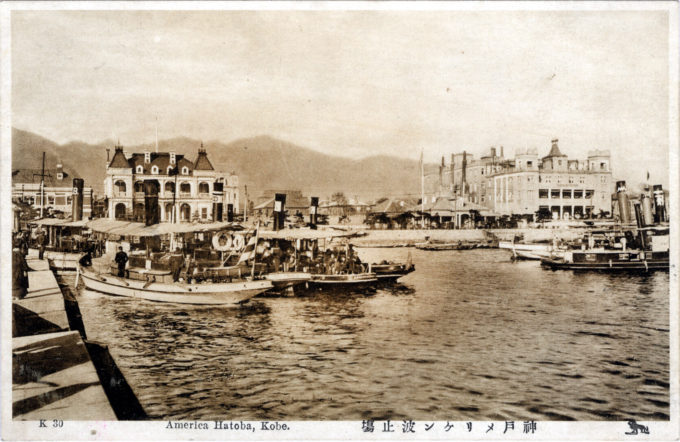
America (or Meriken) Hatoba (wharf or pier), Kobe, c. 1910. Ships’ launches crowd the pier. It was so-named because the US Consular Agency was located at the time at its base on the Bund. The Oriental Hotel is depicted at right, on the Bund.
See also:
Oriental Hotel, Kobe, c. 1910
Located on the Inland Sea, Kobe became one of Japan’s largest ports for trade after its opening to foreign commerce after the Meiji Restoration. By 1903, Kobe handled ¥219MM in trade compared to Yokohama’s ¥228MM. Kobe became particularly noted for its marvelous and artistic designs in cloisonne, pottery, tapestry, weaving, and dyeing. Kobe was first opened to foreign trade, as one of five “treaty ports”, in 1868. Kobe was almost exclusively the foreign settlement (gaikokujin kyoryuchi) of the city of Hyogo to its east until, in 1892, Kobe and Kyogo were incorporated together under the name of Kobe City (Kyoto-shi).
“In reference to the plan of the proposed extension of the Kobe custom house accommodation, the [newspaper] Kwansai Shogyo Nippo observes that the sea between the second or western hatoba [‘wharf’] and the American hatoba along the bund is to be reclaimed to a width of 20 ken or 40 yards, making in all over 5,400 tsubo. Of this area, some 4,070 tsubo are to be occupied by sheds and warehouses.
“The existing American hatoba is to be lengthened 100 ken (200 yards). From its further end, a breakwater 90 ken (180 yards) in length, extending in a southwest direction, is to lie constructed, and at the second hatoba also a breakwater 36 ken (72 yards) long will be constructed. The breakwater will extend practically the whole length of the native bund and will enclose a surface of water about 13,700 tsubo – in extent the depth being about 12 feet at the low tide, making it one big camber. A waterway will be made through the western hatoba in order that communication may be had between the existing camber and the new camber.”
– United States Consular Reports: Reports from the Consuls of the United States, Issues 192-195; by Hon. James Connelly, United States Consul, Kobe, Japan; Bureau of Foreign Commerce, Dept. of Commerce and Labor, 1896
“Steamship Landing: The Amerika hatoba, or American Pier, is at the W end of the Bund; 2 min walk from the Oriental Hotel and 15 min from the Tor. Ships’ launches usually land passengers (no charge) on the pier. Hotel launches meet incoming ships and English-speaking runners conduct passengers ashore (free), take charge of luggage at 25c per package, and pass it through the Custom House (left of the landing). The examination is prompt, courteous and lenient. Passengers are asked if they have any tobacco, cigars, or cigarettes. Sampans (bargaining necessary) are numerous from ship to shore or vice versa; 25-30 sen. The Eastern Nippon Yusen Kaisha and other piers to which some ships go are at the E edge of the Settlement and the Bund, practically the same distance from the hotels.
“Hotels: Tor Hotel Ltd., a new, modern hotel with 70 rooms (each with a bath-room) and accommodations for 100 guests, stands in the midst of fine grounds backed by pine woods at the foot of Suwayama on Yamamoto-dori, at the top of Naka-yamate-dori. Good air; magnificent views. English and German spoken. Rates from ¥7 a day and upward; Am pl. Good food. Reduction for a long stay. Garage; motor-cars.
“Oriental Hotel Ltd., a huge up-to-date, fireproof structure (cost 1 million yen) on the Bund in the Foreign Settlement, overlooking the sea; fine views; close to the banks and business houses. English management; good food. Elevators, roof-garden, hot and cold running water in rooms; set bowls. Popular with all classes. Reading room with many foreign periodicals. Music. Excellent Grill Room. Rates from ¥7.50 and upward. Am pl.; less for ¥2 in a room and for a long stay.
“Minor hotels in less desirable situations are The Mikado (native management; from ¥5 and upward); Central Hotel (¥3.50 to ¥5); Pleasanton Hotel (¥5).”
– Terry’s Japanese Empire, T. Phillip Terry, 1914
“… Among other improvements effected in Kobe Harbor during last year were the extension of the American hatoba, or landing place, for passengers, and the increase of accommodation at the Kawasaki dockyards in preparation for building a warship of 27,000 tons for the Japanese Navy, the yards previously having been capable of building ships of only 8,000 or 9,000 tons.
“A total of 2,502 vessels entered at Kobe in 1911, the tonnage being 5,778,300. In the year before the figures were 2,448 vessels with a tonnage of 5,663,693. Of the 1911 entries, 1,608 were Japanese, 540 British, 144 Germa,n and 53 steamers of 389,366 tons [were] American.”
– ‘Contemplated improvement at Kobe’, Railway and Marine News, October 1, 1912




